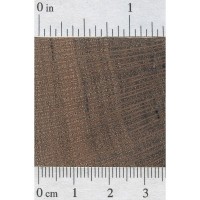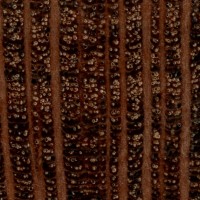 |
Common Name(s): Beefwood Scientific Name: Grevillea striata Distribution: Western Australia Tree Size: 30-45 ft (10-14 m) tall, 1-2 ft (.3-.6 m) trunk diameter Average Dried Weight: 60 lbs/ft3 (965 kg/m3) Specific Gravity (Basic, 12% MC): .78, .96 Janka Hardness: 2,420 lbf (10,770 N) Modulus of Rupture: 13,630 lbf/in2 (94.0 MPa) Elastic Modulus: 2,030,000 lbf/in2 (14.00 GPa) Crushing Strength: 7,830 lbf/in2 (54.0 MPa) Shrinkage: Radial: 3.5%, Tangential: 5.8%, Volumetric: 9.3%, T/R Ratio: 1.7 |
Color/Appearance: Beefwood is a medium to dark reddish brown with lighter reddish grey rays, (perhaps giving it a visual similarity to raw beef: hence the name). Like other woods that exhibit the strongest figure in quartersawn pieces, (such as Sycamore), Beefwood has the most pronounced figure and displays the largest flecks when perfectly quartersawn; this is due to the wood’s large medullary rays, whose layout can be seen the clearest when looking at the endgrain.
Grain/Texture: Has a fairly coarse texture and straight grain.
Endgrain: Diffuse-porous; small to medium pores in tangential rows; solitary and tangential multiples of 2-3; deposits in heartwood occasionally present; growth rings indistinct; very wide rays easily visible without lens; parenchyma banded, diffuse-in-aggregates.
Rot Resistance: No data available.
Workability: Fairly difficult to work because of its high density and tendency to tearout during planing. Beefwood turns, glues, and finishes well.
Odor: No characteristic odor.
Allergies/Toxicity: Although there have been no adverse health effects specifically reported for Beefwood, the closely related Southern Silky Oak (Grevillea robusta) has been reported to cause eye and skin irritation. See the articles Wood Allergies and Toxicity and Wood Dust Safety for more information.
Pricing/Availability: Limited availability within its native range within Australia, Beefwood is virtually never available in other markets such as the United States. Prices are likely to be high.
Sustainability: This wood species is not listed in the CITES Appendices or on the IUCN Red List of Threatened Species.
Common Uses: Inlay, marquetry, turned objects, and other small specialty items.
Comments: Beefwood is in the Proteaceae family, and has wide rays that are characteristic of Lacewood. In its vaguest sense, the term “lacewood” is used to describe any wood that displays figuring that resembles lace, (which would technically include Beefwood). Attempts to identify a specific board macroscopically may be difficult. However, Beefwood can usually be separated from most common species of Silky Oak and Lacewood based upon its darker color and considerably higher density (with the exception of Leopardwood, which also has a higher density).
Proteaceae family:
Scans/Pictures: A special thanks to Steve Earis for providing the wood sample of this wood species.









There is a Bahamian tree locally called beefwood I had a log 6″ dia. and about 2 feet and is the only example I have seen. Very dark reddish and will sink in salt water.
I so like this reference database.
With reference to Beefwood, it grows all over Central Queensland, but extends down into NSW, SA, NT & WA. Likes drier country away from the coast, although it will grow well on creek flats as well as on the ridges.
Often used for fence posts out in the NW of Qld (and elsewhere, I presume).
Subject to borer attack, unfortunately – remains ‘sappy’ long after cut (often large reservoirs of sap will remain for many years).
I am love this timber, and have some aged. Very aged. I commissioned a bedside table and small table top. Even though the oil still in the timber after being saved from a fire, knocked down in the early 1990’s, it still had some oils, and was a real problem sanding. I am wondering if anyone has used this wonderful timber for cutting boards, and has anyone got a problem with toxicity, not from dust, but using the board as a food prep tool. Thanks in advance.
Regarding durability, I have found beefwood survey pegs in the outback which were over 100 years old. Early surveyors favoured beefwood for their pegs because of the long lasting characteristics of the wood.
…yes, have also seen Beefwood survey pegs dating back to immediately post WW1 where Soldiers Settlement land around the arid Marlborough C.Q. region was subdivided into 160acre – approximate – “farms” across Brigalow/Bellah scrublands and including verge of Gum Topped and Ironbark forest which is now “Lorna Vale” Station my parents Arthur and Lorna Rackemann settled in 1959. The proposed Farms were never selected and understandably so because the area was insufficient to sustain a family living despite fertility of the scrubland the rainfall was torrential in Feb/March with little follow up…..and so the region was thrown open for Land… Read more »
Finished beef wood and outer wood, almost like raised chequering
I make resin grazing boards out of this wood and they turn out amazing..
hard to work with but the grain is amazing..
Matthew, do you have a live edge, or coat the cutting board entirely in resin?